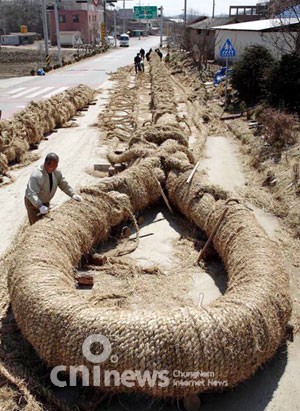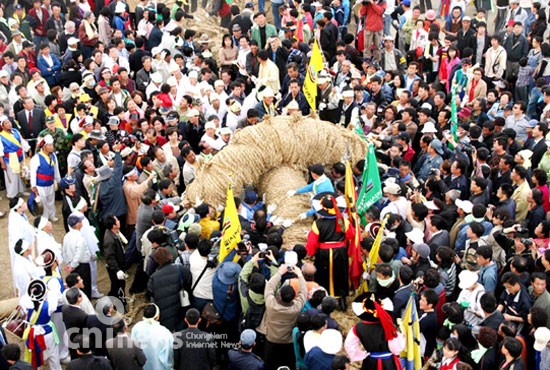About Chungnam
News
Gijisijuldarigi (Gijisi Tug-of-War)
The Ropes are Pulling the World towards Dangjin
2009.08.21(금) | CNnews (![]() chungnamdo@korea.kr)
chungnamdo@korea.kr)
The “Gijisi Tug-of-War” of Dangjin, Chungnam is expected to be appointed as a world cultural heritage. Dangjin-gun took up the project of making the Gijisi Tug-of-War, anImportant Intangible Cultural Asset No. 75, into one of the world’s favorite festivals. It has started the formation of the “Tug-of-War Committee of Korea, China, and Japan,” will spend 3 billion won of its budget on the project for three years from 2007, and will host international tournaments of tug-of-war sports played in 46 nations worldwide. In particular, it focuses on registering the Gijisi Tug-of-War on the UNESCO Cultural Heritage list by 2015 and promoting it as a global festival. The Gijisi Tug-of-War is a folk festival praying for the nation’s peace, good harvest and a bountiful catch. Two ropes, each of which is 100 meters long, 1 meter in diameter, and weighs 20 tons, are connected. As many as 2,500 people then grabbing each of the ropes and try to beat the other in the tug-of-war.
It’s the World’s Biggest Tug-of-War Festival
The tug of war is also called Gilssam or hand weaving. It is one of agricultural rituals played in the form of a gang fight. The village is divided into two sides: the land and the sea. The villagers believed that the sea, which represents the woman and reproduction, should win the fight to give a good harvest in the following fall.
The tug of war is played after the Dangje, a ritual performed in early March of the leaf year on the lunar calendar to prevent woes and pray for a good harvest.
According to the legends, there are two stories on the origin of the tug of war.
The first tells that the village of Gijisiri in Dangjin looked like a Moon Maiden pulling a piece of linen on both ends while weaving the fabric and the play originated from imitating it.
The other tells that the landform resembles a centipede and the villagers played the tug of war with a long rope made in its shape. The length of the rope sometimes is 50∼60m and its diameter is over 1m.
The Gigantic Ropes Connect the Entire Village as One
It is so big that a man can sit on it without his feet touching the ground. Because it cannot be pulled with bare hands, several smaller ropes are tied around the rope several places in the middle. The villagers can pull the rope easily using these smaller ropes. The war starts as the captain from each side stands on the top of the rope and commands his team.
The village band plays a quick music to add to the fun of the game. When the war is over, the winning side keeps the rope.
The winners cut the rope into pieces using a knife and take them home. The villagers believe that the decoction of the rope is effective in curing lumbago and infertility.
For the people of Gijisiri, the tug of war is a folk belief that prevents woes and prays for a good harvest.
Because we can learn a lot about the cooperative rituals in the agricultural society and development in rural life through it, the government designated the tug of war as an important intangible cultural asset
It’s the World’s Biggest Tug-of-War Festival
 |
||
The tug of war is played after the Dangje, a ritual performed in early March of the leaf year on the lunar calendar to prevent woes and pray for a good harvest.
According to the legends, there are two stories on the origin of the tug of war.
The first tells that the village of Gijisiri in Dangjin looked like a Moon Maiden pulling a piece of linen on both ends while weaving the fabric and the play originated from imitating it.
The other tells that the landform resembles a centipede and the villagers played the tug of war with a long rope made in its shape. The length of the rope sometimes is 50∼60m and its diameter is over 1m.
 |
||
The Gigantic Ropes Connect the Entire Village as One
It is so big that a man can sit on it without his feet touching the ground. Because it cannot be pulled with bare hands, several smaller ropes are tied around the rope several places in the middle. The villagers can pull the rope easily using these smaller ropes. The war starts as the captain from each side stands on the top of the rope and commands his team.
The village band plays a quick music to add to the fun of the game. When the war is over, the winning side keeps the rope.
The winners cut the rope into pieces using a knife and take them home. The villagers believe that the decoction of the rope is effective in curing lumbago and infertility.
For the people of Gijisiri, the tug of war is a folk belief that prevents woes and prays for a good harvest.
Because we can learn a lot about the cooperative rituals in the agricultural society and development in rural life through it, the government designated the tug of war as an important intangible cultural asset




